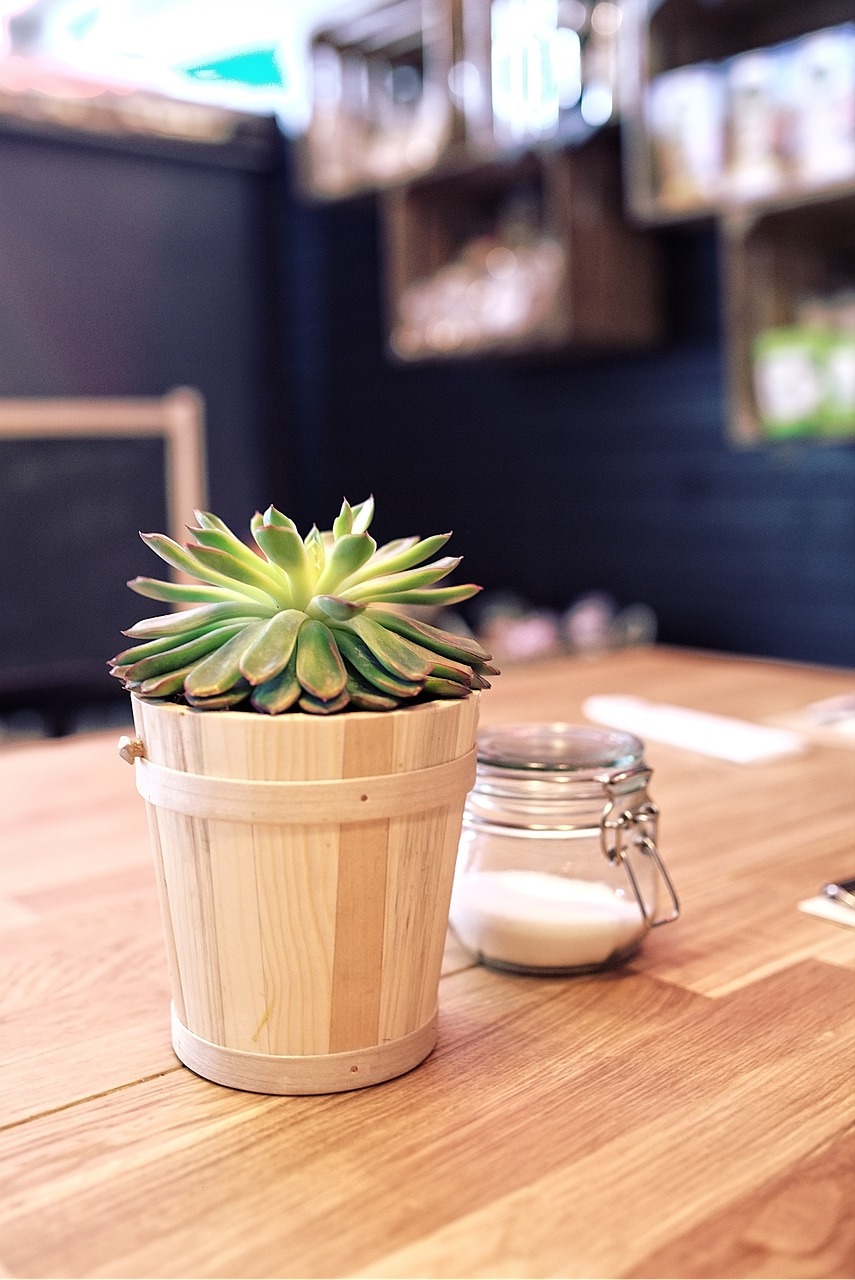Want to grow the hottest pepper in the world? Discover expert Carolina Reaper Growing Tips for robust plants and fiery peppers in this post.
Unlock the secret Carolina Reaper Growing Tips in this comprehensive guide. Whether you’re a novice gardener or a seasoned pro, this post will help you nurture these fiery chili plants to perfection. From soil care to sunlight, we’ve got you covered for a successful harvest.
Botanical Name: Capsicum chinense ‘Carolina Reaper’
Common Names: Carolina Reaper, Habanero Type Pepper, Habanero, Habanero Pepper
USDA Zones: 10a-11b
Learn Best Tips to Make Pepper Plants Hotter
What is Carolina Reaper?
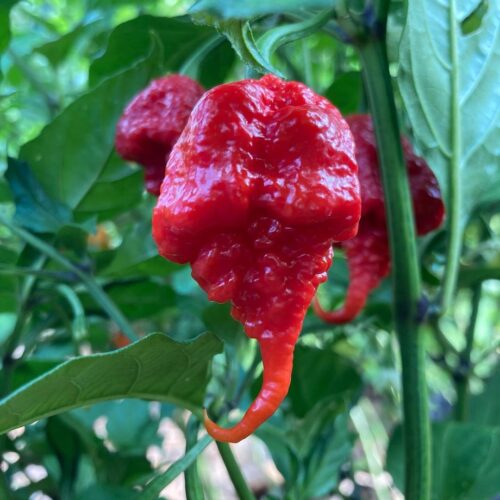
The Carolina Reaper is a very hot chili pepper variety known for its extreme spiciness and distinctive appearance. Here’s everything you need to know about the Carolina Reaper:
Origins and Development:
- The Carolina Reaper was developed by Ed Currie of the PuckerButt Pepper Company in South Carolina, USA.
- It is a crossbreed between a Pakistani Naga pepper and a Caribbean hot pepper called La Soufrière.
Scoville Heat Units (SHU)
- The Carolina Reaper holds the Guinness World Record for the world’s hottest pepper, with an average of 1.64 million Scoville heat units (compared to 3,000-8,000 SHU for average jalapeno), some individual peppers reaching over 2.2 million SHU.
Physical Characteristics
- Carolina Reaper peppers are typically bright red with a wrinkled and lumpy surface, similar in appearance to other superhot chili peppers.
- They have a unique “stinger” tail at the bottom, which is one of their distinctive features.
Flavor Profile
- Beyond its extreme spiciness, the Carolina Reaper is described as having a fruity and slightly sweet flavor, often followed by intense heat.
Culinary Use
- Due to their extreme heat, Carolina Reaper peppers are not typically used in large quantities in dishes. Instead, they are used sparingly to add intense spiciness to sauces, salsas, and marinades.
- Some people enjoy using Carolina Reaper peppers to make hot sauces, chili extracts, and spicy snacks.
Handling and Safety:
- Handling Carolina Reaper peppers requires caution. It’s essential to wear gloves when working with them and avoid touching your face, especially your eyes, after handling them.
- People with a low tolerance for spicy foods should be extremely cautious when consuming Carolina Reaper peppers, as they can cause intense burning sensations and discomfort.
Health Benefits:
- Like other chili peppers, Carolina Reapers contain capsaicin, which is associated with several potential health benefits. These include pain relief, improved metabolism, and anti-inflammatory properties.
- However, the extreme heat of Carolina Reapers may limit their practical use for these benefits, as consuming them in large quantities can be challenging and uncomfortable.
Popularity and Challenges
- The Carolina Reaper has gained popularity in recent years among chili pepper enthusiasts and daredevils seeking the ultimate spicy experience.
- Eating a whole Carolina Reaper pepper or even a small piece is often done as part of spicy food challenges, but it should be approached with extreme caution due to its intense heat.
READ about Black Pepper Plant Growing Zone Tips
How to Propagate Carolina Reapers
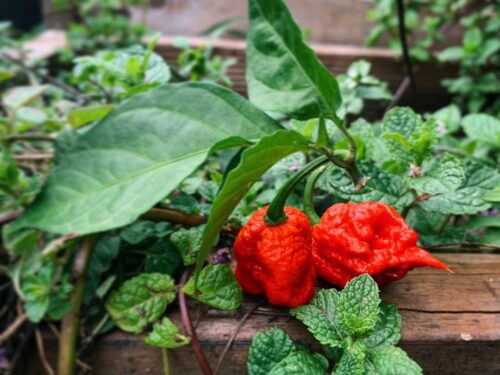
Most pepper plants are simple to grow, but growing Carolina Reaper plants are slightly different. They need more time, up to five months, from when you plant them outside to when you can pick ripe peppers.
Propagation methods for Carolina Reaper pepper plants:
- Seed Germination
- Cuttings
- Grafting
The easiest method for propagating Carolina Reaper peppers is Seed Germination:
Growing Carolina Reaper from Seeds
Materials Needed:
- Carolina Reaper pepper seeds
- Seedling trays or pots
- Seed starting mix (well-draining)
- Plastic wrap or a humidity dome
- Warm, bright location or grow lights
- Water
- Fill a seedling tray or small pots with a well-draining seed starting mix. Ensure the containers have drainage holes.
- Plant Carolina Reaper pepper seeds about 1/4 inch deep in the soil. Space them at least 2 inches apart.
- Water the soil thoroughly but gently. Ensure the soil is consistently moist but not waterlogged.
- Cover the seed tray or pots with a clear plastic wrap or a humidity dome. This helps create a greenhouse effect and maintain humidity.
- Place the seed tray or pots in a warm location with indirect sunlight or under grow lights.
- Carolina Reaper peppers require temperatures of around 80-85°F (27-29°C) for optimal germination.
- Check the soil moisture regularly and water as needed to keep it consistently moist but not soggy. Be careful not to overwater, as this can lead to fungal issues.
- Once the seedlings have developed a couple of true leaves and are strong enough to handle, transplant them into larger pots or directly into the garden (if the outdoor conditions are appropriate).
- Gradually acclimate the seedlings to outdoor conditions by exposing them to sunlight and reducing humidity.
- Afterward, transplant them to their final growing location, whether in the ground or larger containers.
Note: You can safely move your Carolina Reaper plants outdoors permanently when nighttime temperatures consistently stay above 55°F, typically occurring about 2-3 weeks following the last frost date in your area.
Check Tips for Growing Eggplant in Containers
Pot Size for Growing Carolina Reapers
Carolina Reaper pepper plants, belonging to the C. chinense species, have the potential to grow quite large in a single season, often reaching heights of up to 5 feet or more under optimal conditions. To ensure a bountiful harvest of Carolina Reaper peppers, it’s advisable to select a container with a capacity of approximately 5-7 gallons, roughly equivalent to 1 cubic foot.
However, if space limitations require a smaller pot, be aware that it may affect your whole pepper harvests.
CHECK Plants That Look Like Dill
Ideal Growing Conditions for Carolina Reaper

Sunlight
For Seedlings:
Carolina Reaper seedlings need bright, indirect sunlight initially. Place them near a south-facing window or under grow lights for 12-16 hours a day. Maintain even moisture to avoid drying out. Once they grow stronger, gradually introduce them to direct sunlight for short periods to acclimate.
For Established Plants:
Carolina Reaper plants thrive in full sun. Plant them in a sunny, south-facing location for 6-8 hours of direct sunlight daily. Adequate air circulation prevents diseases. In hot climates, provide some afternoon shade to shield from intense heat.
Soil
Soil Type: Carolina Reaper peppers thrive in well-draining, loamy soil. A mix of garden soil and organic matter (like compost) is ideal.
Soil pH: Maintain a slightly acidic to neutral pH level between 6.0 and 7.0 for optimal growth.
Amendment Ratio: Amend the soil with compost or well-rotted manure at a ratio of 1:3 (one part compost to three parts soil). This improves nutrient content and drainage, promoting robust Carolina Reaper plant growth.
Water
For Seedlings:
Water Carolina Reaper seedlings gently, keeping the soil moist but not waterlogged. Use a spray bottle or a gentle watering can. Water when the top inch of soil feels dry, typically every 2-3 days. Ensure good drainage.
For Established Plants:
Water established Carolina Reaper plants deeply but less frequently. Allow the top 2-3 inches of soil to dry between watering. Provide water when the plant shows signs of wilt or when the soil is dry to touch, typically every 4-7 days, depending on weather conditions and soil moisture retention. Use a soaker hose or drip irrigation to water at the base, avoiding wetting the foliage to prevent disease.
Temperature
Carolina Reaper peppers thrive in warm temperatures. They prefer a temperature range of 70-85°F (21-29°C) during the day and above 55°F (13°C) at night. They are well-suited for USDA Hardiness Zones 9-11, but they can also be grown in lower zones as annuals during the warm season.
Is Broccoli Man Made or a Product of Nature? FIND OUT
Carolina Reaper Care
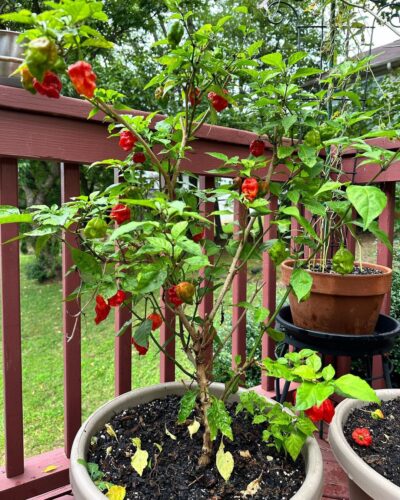
Fertilizer
For Seedlings: Use balanced fertilizer 10-10-10, diluted to half strength. Apply every 2-4 weeks during the growing season.
While Blooming: Apply high-phosphorus fertilizer in the flowering and fruiting stage, and feed pepper with a fertilizer high in phosphorus (for e.g. 10-30-10).
For Established Plants: Use balanced fertilizer 10-10-10 every 4-6 weeks during the growing season. Reduce or cease fertilization during dormancy in winter.
Mulching
Mulching Carolina Reaper pepper plants help control weeds, retain soil moisture, and regulate soil temperature. It’s especially beneficial in raised or in-ground beds. Use materials like straw, grass clippings, wood chips, or black plastic to create a protective layer around the plants, enhancing their overall health and productivity.
Staking
It’s crucial to provide support for Carolina Reaper plants, even from an early stage, as they can be susceptible to strong winds. This is particularly important during the initial weeks outdoors and later when the peppers start to form. You can use materials like bamboo or metal T-posts as vertical stakes to keep your plants upright. Secure the plant stem to the stake using plant velcro to maintain stability throughout the growing season.
Pruning
Pruning Carolina Reaper pepper plants involves removing unnecessary foliage and branches to improve air circulation, light penetration, and fruit production. Focus on removing non-productive branches and any dead or diseased growth. Pruning can encourage healthier plants and increase the overall yield of hot peppers.
Pest and Diseases
Carolina Reaper pepper plants can face various pests and diseases. Common pests include aphids, spider mites, and whiteflies, which can be controlled with insecticidal soap or neem oil.
Diseases such as bacterial wilt, powdery mildew, and root rot may occur. Proper watering, good air circulation, and preventive measures like crop rotation can help minimize these issues.
Regular inspection and early intervention are essential for maintaining plant health and maximizing pepper production.
Find The Difference Between Tomato Paste and Tomato Sauce
Harvesting Carolina Reaper Peppers

Tip: Carolina Reaper peppers are extremely hot and can irritate your skin. Wear gloves when harvesting and handling them.
For optimal heat and flavor, it’s best to harvest Carolina Reapers once they’ve turned bright red. While unripe ones are edible, the just-turned red peppers pack the most punch.
When harvesting, handle them with care to avoid breaking the skin, which can release spicy juices. Pluck them by the stem, not the fruit, to prevent any skin irritation.
Read Malabar Spinach Benefits
What You Can Do with Carolina Reaper
1. Hot Sauces:
Carolina Reapers are a popular choice for making ultra-spicy hot sauces. Combine them with other ingredients like tomatoes, vinegar, and garlic to create your own signature sauce.
2. Salsas:
Chop and add small amounts of Carolina Reaper to homemade salsas for an extra kick. Balance the heat with ingredients like tomatoes, onions, and cilantro.
3. Spicy Pickles:
Slice Carolina Reapers and add them to your pickle recipe for fiery pickles. They can also be included in relishes and chutneys.
4. Seasoning:
Dry Carolina Reaper peppers and grind them into a powder. A tiny pinch of this potent spice can add intense heat to dishes like chili, curry, or even a Bloody Mary.
5. Infused Oils and Vinegar:
Create infused oils or vinegar by placing whole Carolina Reapers in bottles with your chosen liquid. Over time, the heat and flavor will infuse into the liquid, which can be used for cooking or as a condiment.
6. Dried Peppers:
Dehydrate Carolina Reaper peppers to preserve them for later use. You can then rehydrate them in recipes like stews or soups.
Caution: Remember that Carolina Reapers are incredibly spicy, so use them sparingly in your recipes. It’s always a good idea to taste a small amount before adding more to gauge the heat level. Also, handle them carefully, wear gloves, and avoid touching your face or eyes when working with these peppers, as the oils can cause irritation and burns.
LEARN Betel Leaf Plant Care and Growing Guide
Tips to Boost the Heat of Carolina Reaper Peppers
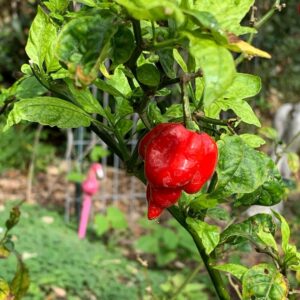
- Optimal Growing Conditions: Provide ideal growing conditions, including full sun exposure, well-draining soil, and consistent watering. Stressing the plant slightly can result in hotter peppers.
- Reduce Watering During Ripening: In the weeks leading up to harvest, reduce watering to stress the plant. Dry conditions can intensify the heat of the peppers.
- Allow Peppers to Ripen Fully: Harvest Carolina Reapers when they turn bright red or orange. Fully ripe peppers tend to be hotter than unripe ones.
- Prune Carefully: Pruning can redirect the plant’s energy to the remaining peppers, making them hotter. Trim excess foliage and non-productive branches.
- Avoid Over-fertilization: While peppers need nutrients, excessive fertilization can lead to milder peppers. Use balanced fertilizer sparingly.
- Natural Stressors: Exposing plants to natural stressors like temperature fluctuations or occasional drought can increase capsaicin (the compound responsible for heat) production.
- Selective Breeding: Consider saving seeds from the hottest peppers for future plantings. Over generations, this can result in even hotter Carolina Reaper peppers.
Remember, Carolina Reapers are already incredibly spicy, so exercise caution when handling and consuming them. Be mindful of their intense heat, and use them sparingly in your recipes to avoid overwhelming your taste buds.
READ Chilacayote Squash Care
FAQs- Carolina Reaper Peppers
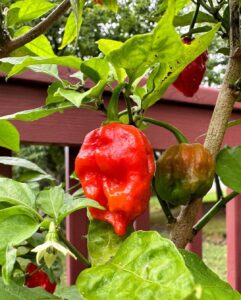
Q: Can I grow Carolina Reapers in pots?
A: Yes, but choose a large container (5-7 gallons) with good drainage.
Q: How do I store harvested Carolina Reapers?
A: Store them in a cool, dry place, or dry them for later use in cooking or as seasonings.
Q: Can I grow Carolina Reapers indoors?
A: Yes, you can grow them indoors, but ensure they receive adequate sunlight or use grow lights.
Q: How long does it take for Carolina Reaper peppers to ripen after flowering?
A: Typically, it takes around 70-90 days for Carolina Reapers to ripen after flowering, but it can vary.
Q: How do I prevent Carolina Reapers from cross-pollinating with other pepper varieties?
A: Isolate Carolina Reapers from other pepper types or use hand pollination techniques to control cross-pollination.
Q: Are there any companion plants that can benefit the Carolina Reaper plant’s growth?
A: Some gardeners suggest basil, oregano, or marigolds as companion plants to deter pests.
Q: Where can I buy Carolina Reaper pepper seeds or plants?
A: You can purchase Carolina Reapers seeds or young plants from reputable online seed suppliers, local nurseries, or gardening centers. Ensure they are from trusted sources to get quality plants.


